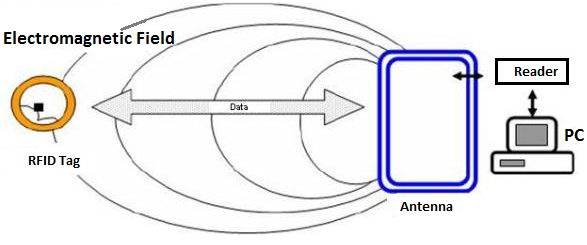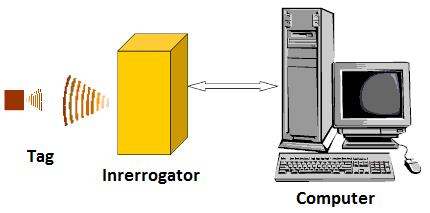RFID is abbreviation of Radio Frequency Identification. RFID signifies to tiny electronic gadgets that comprise of a small chip and an antenna. This small chip is competent of accumulating approx 2000 bytes of data or information. RFID devices is used as a substitute of bar code or a magnetic strip which is noticed at the back of an ATM card or credit card, it gives a unique identification code to each item. And similar to the magnetic strip or bar code, RFID devices too have to be scanned to get the details (identifying information).
Outline
ToggleRFID Technology
A fundamental advantage of RFID gadgets above the other stated devices is that the RFID device is not required to be placed exactly near to the scanner or RFID code reader. As all of us are well aware of the difficulty which store billers face while scanning the bar codes and but obviously the credit cards & ATM cards need to be swiped all though a special card reader. In comparison to it, RFID device can function from few feet away (approx 20 feet for high frequency devices) of the scanner machine.
Related Post: RFID Project Ideas for Engineering Students
Functioning Principle of RFID Device:
- RFID (radio frequency identification) is a technique facilitating identification of any product or item without the requirement of any line of sight amid transponder and reader.
- RFID Structure is continuously composed of 2 main hardware components. The transponder which is located on the product to be scanned and the reader which can be either just a reader or a read & write device, depending upon the system design, technology employed and the requirement. The RFID reader characteristically comprise of a radio frequency module, a controlling unit for configurations, a monitor and an antenna ti investigate the RFID tags. In addition, a number of RFID readers are in-built with an extra interface allowing them to forward the data received to another system (control system or PC).
- RFID Tag – The actual data carrying tool of an RFID structure, in general comprise of an antenna (coupling element) and an electronic micro-chip.
Active & Passive Tags:
Before we move ahead to the working of the RFID systems let us know what active & passive RFID tags are –
RFID is a common term employed to describe a device which is employed in transferring data with the help of radio waves. RFID tags comprise of a RFID transceiver for transferring data from one system to another. There are 2 kinds of RFID tags- Active tags & Passive tags.
[adsense2]
Passive RFID Tags:
Passive tags comprise of 3 key components, namely, an in-built chip, a substrate and an antenna. The in-built chip is also known as a circuit and is utilized to perform some precise tasks along with accumulating data. Passive RFID tags can comprise of various kinds of micro-chips depending on the structural design of a particular tag. These chips can be MO (read only) or WORM (write once chip other than read many) or RW (read write) chip. A general RFID chip is competent of accumulating 96 bits of data but some other chips have a capacity of storing 1000-2000 bits.Passive tag has an antenna which is attached to the micro-chip. This antenna is employed for transferring data using radio waves. The passive tag’s performance is reliant on the size of the antenna. In the performance of tags the shape of the antenna also plays a significant role. The third part of the tag is substrate , the substrate is a plastic coating or Mylar which is employed to unite the antenna & the chip. Passive RFID tags are smaller in size as well as cheap on pockets too.
Active RFID Tags:
Active tags comprise of same components that exists in passive tags. They too comprise of a micro-chip and an antenna but the only comparison between the two is that the size of the micro-chip in active tags is larger than passive tags’ chip. An active tag is incorporated with a built-in power supply. Maximum of the active tags make use of batteries whereas some of them work on solar cells. The inbuilt power system facilitates the tag to be used as an independent reader which is competent of transferring information devoid of outer assistance. Active RFID tags are available with some extra features such as microprocessors, serial ports & sensors. The highly developed technology in existing in active RFID tag formulates it more capable in comparison to passive tags as the active tags can be easily employed for a large array of tasks.
RFID Micro-Chip tags are basically fabricated to function at certain frequencies which are license free.
These are:
- High Frequency (HF) 13.56 MHz
- Microwave 2.45 GHz
- Ultra High Frequency (UHF) 868-930 MHz
- Low Frequency (LF) 125-135 KHz
- Microwave 5.8 GHz
How RFID Works:
The diagram below describes the fundamental working of all RFID systems. The transponder or tag can be either active of passive tag. It reacts to the signals from the reader or writer or interrogator which in turn conveys signals to the computer.
RFID Applications:
RFID technology is used in a number of industries to carry out various tasks such as:
- Asset tracking
- Inventory management
- Controlling access to confined areas
- Personnel tracking
- Supply chain management
- ID badging
- Counterfeit forestalling (e.g., in the pharmaceutical industry)
Even though RFID technology has been in used by humans ever since from World War II, the stipulate for RFID devices is rising quickly, in fact owing to orders given by the U.S. DoD (Department of Defense ) and Wal-Mart needing their suppliers to modify products to be traced by RFID technology.
RFID is also employed in a number of other things:
- The keys to unlock your car door;
- The automatic deduction of payment while using toll booths;
- Building access systems;
- Payment cards, student ID cards and even Passports
- Wireless sensors & mesh networks.
Whether RFID technology submissiveness is necessary, applications that at present make use of bar code technology are excellent options for upgrading them to a technology that brings into play RFID or some admixture of the two technologies. RFID proffers a number of advantages in contrast to the bar code, precisely the fact is that an RFID tag can store more amount of data about a particular product than a bar code can. Additionally, RFID tags are not exposed to the afflictions that may happen with bar code labels, such as breaking and blackening.




One Response
Just what I was searching for, regards for putting up.